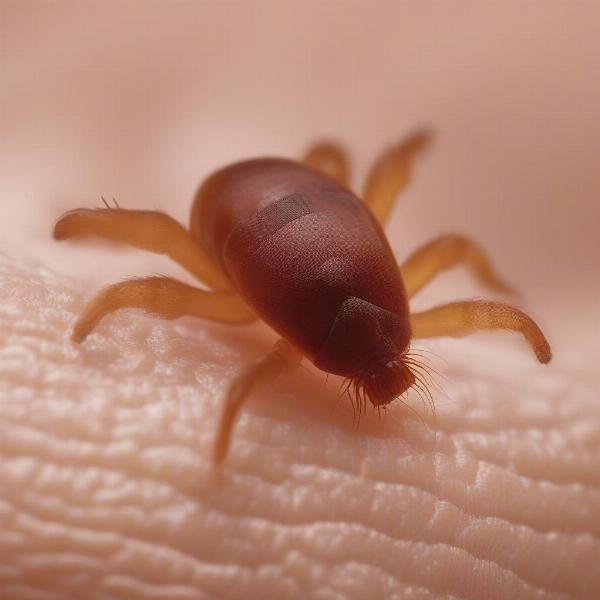Flea and tick infestations can be a nightmare for both dogs and their owners. These pesky parasites not only cause itching and discomfort but can also transmit serious diseases. Effective flea & tick control for dogs is crucial for maintaining their health and well-being. This comprehensive guide will cover everything you need to know about protecting your furry friend from these parasites, from prevention strategies to treatment options.
Understanding the Threat: Why Flea & Tick Control is Important
Fleas and ticks are more than just a nuisance. They can cause a range of health problems, from skin irritations and allergies to life-threatening diseases like Lyme disease, ehrlichiosis, and Rocky Mountain spotted fever. Regular flea & tick control isn’t just about comfort; it’s about safeguarding your dog’s health.
 Flea and tick on dog's skin
Flea and tick on dog's skin
Prevention Strategies: Keeping Fleas and Ticks at Bay
Preventing infestations is always better than treating them. Several proactive measures can significantly reduce your dog’s risk of exposure to fleas and ticks. These include:
- Regular Yard Maintenance: Keep your grass short and remove leaf litter and debris where ticks like to hide.
- Avoid Tick-Infested Areas: Stay away from wooded areas and tall grasses, especially during peak tick season.
- Use Preventative Products: A variety of flea and tick preventatives are available, including topical treatments, oral medications, and collars. Consult your veterinarian to determine the best option for your dog.
Treatment Options: Getting Rid of Existing Infestations
If your dog already has fleas or ticks, prompt treatment is essential. Several effective treatment options are available, each with its own pros and cons.
Topical Treatments
Topical treatments are applied directly to your dog’s skin and are absorbed into the bloodstream. They are effective against both fleas and ticks and are available in various formulations.
Oral Medications
Oral medications are given by mouth and work systemically to kill fleas and ticks. They are often more convenient than topical treatments and provide longer-lasting protection.
Flea and Tick Collars
Flea and tick collars release insecticide over time, killing and repelling parasites. They are a convenient option for long-term prevention.
Choosing the Right Flea & Tick Control for Your Dog
The best flea & tick control method for your dog will depend on several factors, including their age, breed, lifestyle, and any existing health conditions. Consult your veterinarian to discuss the best options for your individual dog. They can help you weigh the pros and cons of each method and choose the safest and most effective solution.
Conclusion: Protecting Your Furry Friend from Fleas and Ticks
Flea & tick control is a vital part of responsible dog ownership. By taking proactive steps to prevent infestations and treating existing ones promptly, you can protect your furry friend from these pesky parasites and the health risks they pose. Remember to consult with your veterinarian to determine the best flea and tick control strategy for your dog’s individual needs.
FAQ: Common Questions About Flea & Tick Control
- How often should I treat my dog for fleas and ticks? This depends on the product you are using. Follow your veterinarian’s recommendations and the product label instructions.
- Are natural flea and tick remedies effective? While some natural remedies may offer some repellent properties, they are generally not as effective as conventional products. Consult your vet before using any natural remedies.
- Can fleas and ticks infest my home? Yes, fleas and ticks can infest your home, especially if your dog brings them inside. Regular cleaning and vacuuming are essential for preventing infestations.
- What are the signs of a flea or tick infestation? Signs include excessive scratching, biting, hair loss, and skin irritation. You may also see the parasites themselves on your dog’s fur.
- What should I do if I find a tick on my dog? Remove the tick promptly using tweezers, grasping it as close to the skin as possible. Clean the area with antiseptic and monitor your dog for any signs of illness.
- Can I use the same flea and tick product on my cat and dog? No, some products designed for dogs can be toxic to cats. Always use products specifically formulated for the correct species.
- Are there any side effects of flea and tick medications? Some dogs may experience mild side effects, such as temporary skin irritation or gastrointestinal upset. Contact your veterinarian if you notice any concerning side effects.
Related Articles:
- natural flea & tick prevention for dogs
- flea & wormer for dogs
- natural tick spray dogs
- cat & dog repellent get off
ILM Dog is your trusted resource for expert advice on dog breeds, health, training, nutrition, grooming, and much more. We provide practical tips and insights to help dog owners worldwide provide the best possible care for their furry companions. From puppy care to senior dog care, we cover all aspects of dog ownership. Whether you’re looking for information on dog products and accessories or advice on traveling with your dog, ILM Dog has you covered. Contact us today for personalized guidance: Email: [email protected], Phone: +44 20-3965-8624.